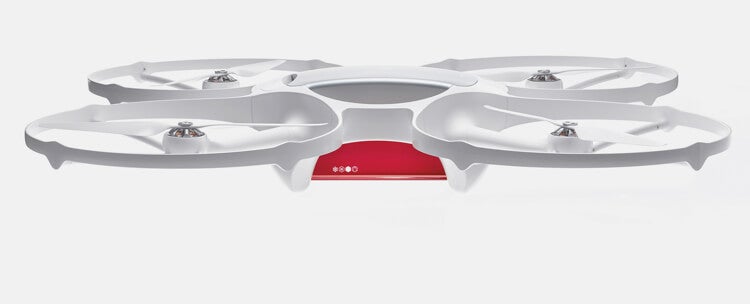We’ve covered drone delivery startup, Matternet, for a few years now. Before Amazon’s Jeff Bezos talked drone delivery on “60 Minutes,” Matternet was already working the problem. But their vision didn’t begin with retail and e-commerce—it began with getting medicine and other key goods to those in need.
Matternet envisioned a drone network (like an Internet for material things) in developing countries, where poor roads seasonally cut off rural villages from needed items. Over the last few years, they’ve worked to show their concept could improve access by testing systems in places like Haiti and Papua New Guinea.
What did they find? Matternet cofounder and CEO, Andreas Raptopoulos says some 80% of the almost 180 rural clinics they distributed medicine to in Bhutan—working with the World Health Organization—were within a 30-minute drone flight of a hospital.
In other words, medicine and other goods can be relatively near as the crow flies and yet still very difficult to access on the ground. Challenging terrain or washed out roads might convert an easy trip through the air into a multi-hour (or multi-day) slog over a maze of mud and muck.
Whereas road infrastructure is expensive to build and maintain, drones might offer an affordable alternative. Raptopoulos estimates a 150-drone network servicing 140 square miles would cost $900,000.
Despite a few years’ field tests, however, much of the idea is still on paper. Ready to take the next step, Matternet recently announced their first product, Matternet ONE, is ready to go. Matternet ONE isn’t just a drone, it’s an autonomous drone-based delivery system, as dependent on software as it is hardware.
Here’s how it works.
The drone itself looks like most drones you’ve seen. The craft’s all-white body and four guarded propellers surround a central, cherry red payload compartment (to stash medicine, documents, whatever else). Also like other drones, it’s battery-powered and can carry supplies weighing a kilogram (2.2 lbs) up to 20 km (12.4 miles) on a single charge. (Matternet says two thirds of everyday items weigh less than 1 kilogram.)
But here’s where Matternet ONE is different from most other drones—no pilots are required. The drone flies itself to and from destinations. Also, because it’s a delivery system, the drone may need to fly further than limited battery life allows. The solutions to these problems are on the ground and in the cloud.
Matternet ONE makes use of fixed landing stations. These stations perform two critical functions. First, if the destination is beyond a single charge, they extend the drone’s range by swapping out a dead battery for a fresh one. Second, they allow the drone to plan its flight path in advance and map out obstacles in detail.
Because drones can’t yet sense and avoid obstacles—trees, power lines, people—guidance from ground stations and fixed flight paths make for safer autonomous flights. Also, the drones remain connected to central guidance software in the cloud, maintaining (or altering) their trajectory throughout a flight.
The system maps obstacles but also restricted airspace (near airports for example). And though at first Matternet ONE will be used in sparsely populated areas, it has a parachute for any unforeseen, catastrophic system failures—hopefully limiting damage to the craft and anyone walking under it.
With all this working behind the scenes, users don’t need training to operate Matternet ONE. They can load up a drone and, using a smartphone app, select the destination, hit send, and watch it rise into the air.
The vehicles are also fairly rugged. The company says Matternet ONE can fly in moderate rain, wind up to 20 knots (23 mph), and temperatures ranging from -10° to 50° C (14° to 122° F). It’s a good range for most day-to-day requirements, though flying through a storm would be sketchy. (And to skip washed out roads during monsoon season, users will have to look for a window in the weather, which could be limiting.)
Matternet ONE starts at $5,000 and, initially, is only available by invitation. The firm says this is to ensure their first batch finds diverse applications worldwide. And make no mistake, their aim is wide.
“We want to be the people that enable FedEx and UPS and many other smaller and bigger players to take [drone delivery] to the marketplace and make it widespread,” Raptopoulos told the Wall Street Journal.
Matternet’s vision extends from developing country drone networks to courier service in megacities. But as regulation is still taking shape in countries like the US, the former is likely to happen before the latter. Recently proposed FAA rules requiring drones to remain within eyeshot of operators would preclude use of Matternet ONE in the US. (That may change as “sense and avoid” technology becomes available.)
Other worries will have to be addressed too, like safety in densely populated areas (no one wants to take a malfunctioning drone to the head). And two other concerns, privacy and noise, may be hard to untangle—the quieter the better, but also the less likely you’ll hear a drone hovering outside your window.
Ultimately, we’ll only strike the best balance between risk and benefit by experimenting. Other countries are already more open to the tech, and the FAA’s rules would still allow some kinds of trials in the US too. Chris Anderson, CEO of 3D Robotics, is optimistic about the regulation and expects rapid growth.
“All I wanted was a sandbox where we could innovate,” he told the WSJ. “Now we’ve got that sandbox and I think you’ll see an explosion of creativity and energy and investment in this space going forward.”
Image Credit: Matternet




